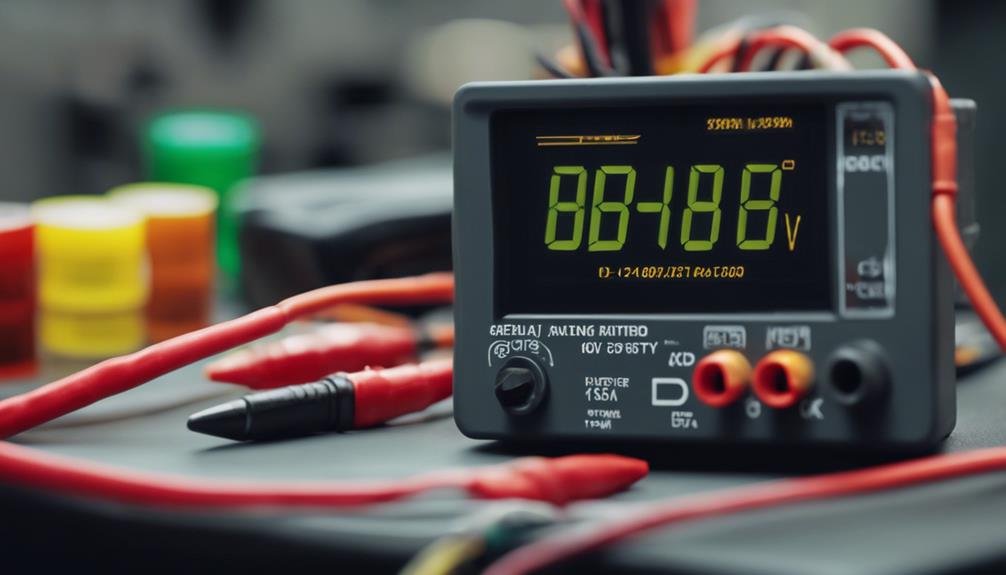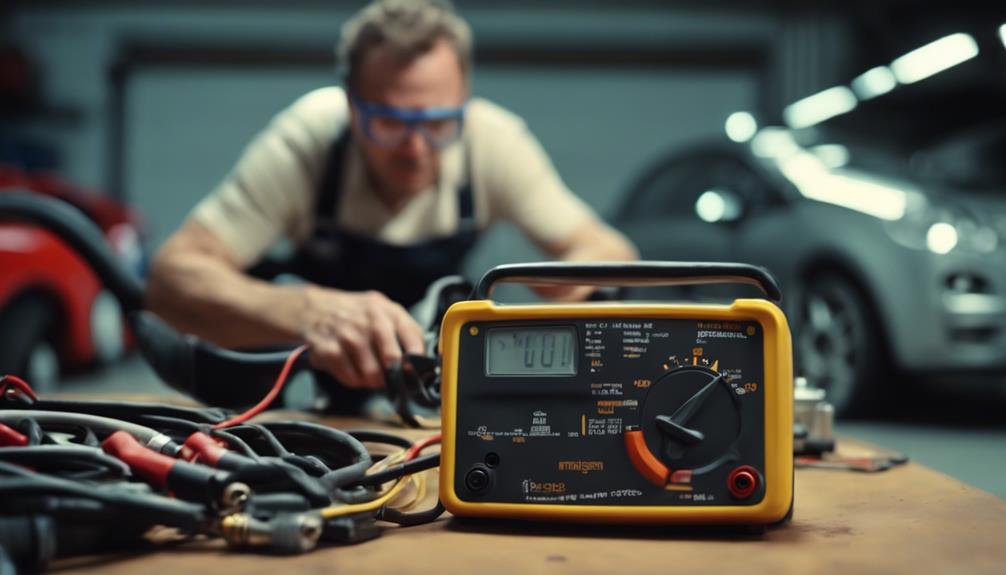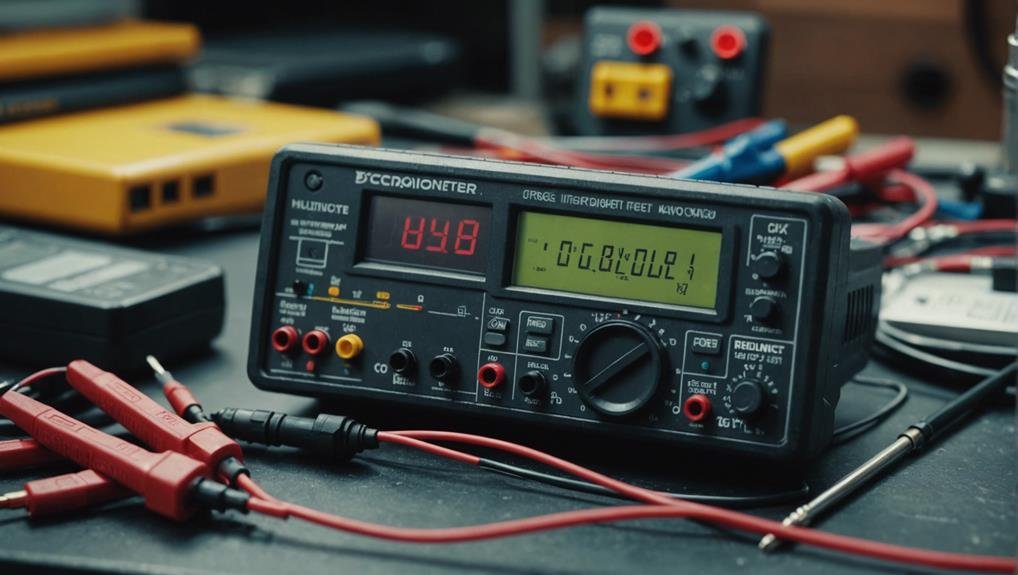When testing your car battery with a multimeter, begin by setting the multimeter to the DC voltage setting and familiarize yourself with the dial. Connect the red probe to the positive terminal and the black probe to a bare metal surface on the vehicle. Confirm secure connections to prevent errors. Take voltage readings when the battery is at rest, and a healthy battery should read around 12.6V. Continue to investigate how to interpret voltage readings, test the alternator, and identify common battery issues, and you'll be well on your way to gaining a deeper understanding of your vehicle's electrical system.
Key Takeaways
- Set your multimeter to DC voltage and connect the red probe to the positive terminal and black probe to a bare metal surface on the vehicle.
- A healthy car battery should read around 12.6V when at rest, and between 13.8V to 14.4V when the engine is running.
- Remove surface charge before testing the battery to get accurate results, and low voltage readings may indicate the need for further testing or replacement.
- To test the alternator, connect the multimeter leads to the alternator's output terminals and record the voltage reading at idle speed while the engine is running.
- Regularly testing your car battery with a multimeter helps prevent unexpected breakdowns, saves time and money, and enables early detection of battery issues.
Preparing Your Multimeter
Set your multimeter to the DC voltage setting, usually found in the range of 15-20 volts, specifically designed for car batteries. This setting will allow you to accurately measure the voltage of your car's battery.
Take a moment to familiarize yourself with your multimeter's dial and make sure you're on the correct setting. You'll typically find the DC voltage setting indicated by a V symbol or a battery icon. Set the dial to the appropriate range, as specified in your multimeter's user manual.
Remember, the positive and negative terminals are important when working with batteries. You'll connect the red probe to the positive terminal and the black probe to the negative terminal. Double-check that your multimeter is set correctly before moving forward. A correct setup is necessary for accurate readings.
With your multimeter prepared, you're ready to move on to the next step: connecting the probes to the car battery.
Connecting the Probes
With your multimeter properly configured, connect the red probe to the positive terminal of the car battery, ensuring a secure attachment. This connection is important for accurate voltage measurement.
Next, connect the black probe to a bare metal surface on the vehicle, such as a bolt on the engine block or a metal bracket. Make sure the connection is secure, as a loose connection can lead to false readings.
Double-check that both probes are securely attached to prevent any errors during the testing process. Proper probe connections are necessary for measuring the voltage of the car battery effectively.
The multimeter probes help establish a complete circuit for voltage measurement during the battery testing process. By following these steps, you'll be able to take accurate voltage readings, which is crucial for determining the health of your car battery.
Reading the Voltage

You'll get an accurate reading by turning the multimeter dial to the voltage range that corresponds to your car battery's voltage, usually 20 volts or less. This guarantees the multimeter is set to measure the battery voltage correctly.
For a car battery, the resting voltage is critical, as it indicates the battery's state of charge. A healthy car battery should ideally have a resting voltage of around 12.6 volts.
When the engine is running, the battery voltage should read between 13.8 to 14.4 volts for a properly functioning charging system. If the battery voltage drops below 12.6 volts, it may indicate a need for charging or potential battery issues.
Take note that the voltage reading can fluctuate after driving the vehicle, so it's important to take the reading when the battery is at rest.
Understanding the Results
Understanding the results of your multimeter test is vital in determining the health of your car battery. Interpreting the voltage reading correctly is key in identifying potential issues. A reading of 12.6 volts or higher indicates a healthy battery, while anything below that suggests a potential charging issue.
However, it's important to remove any surface charge before testing to guarantee accurate results. When interpreting the voltage reading, be aware that voltage drops under load can provide valuable insight into the battery's health. Consistently low voltage readings may indicate the need for further testing or even replacement.
Moreover, monitoring the specific gravity of the battery's electrolyte can provide further insight into its health. By understanding the results of your multimeter test, you'll be better equipped to identify and address any issues before they leave you stranded. Remember, accurate interpretation of the voltage reading is critical in determining the health of your car battery.
Testing the Alternator

To ensure your car's electrical systems function properly, it's essential to test the alternator, which should generate a voltage between 13.8V and 14.4V at idle speed to charge the battery and power the car's electrical systems. Deviations from this ideal voltage range while the engine is running indicate potential issues with under or overcharging, which can lead to premature battery failure and electrical system malfunctions.
To test the alternator, follow these steps:
- Connect your multimeter: Attach the multimeter leads to the alternator's output terminals.
- Take a reading: Record the voltage reading on your multimeter while the engine is running at idle speed.
- Analyze the result: Compare the reading to the ideal voltage range to determine if the alternator is functioning properly.
Monitoring the alternator's output voltage is essential for maintaining a healthy charging system and ensuring proper functioning of the vehicle's electronics. By testing the alternator, you can identify potential issues before they cause serious problems.
Common Battery Issues
Corrosion, worn-out terminals, and loose connections can weaken your car's battery, leading to a range of issues that can leave you stranded. When you notice slow engine turnover when starting the car, it may indicate a weak or failing battery that needs attention.
Dimming headlights while the engine is running can be a sign of a faulty alternator not charging the battery properly. If you hear clicking noises when turning the key in the ignition, it may suggest a low battery charge or a problem with the starter.
Regularly checking for signs of battery issues, like the battery light on the dashboard, can help prevent unexpected breakdowns. A bad car battery can be a real hassle, but identifying the problem early on can save you time and money.
To test a car battery, you'll need a multimeter, which can help you diagnose whether the issue lies with the battery or the alternator. By understanding these common battery issues, you'll be better equipped to identify and address problems before they leave you stranded.
Maintenance and Care

You can extend the life of your car battery by following a few simple maintenance habits, including regular cleaning of terminals and securing connections. By doing so, you can prevent corrosion and guarantee proper electrical connections.
Furthermore, regular car maintenance, such as testing your car battery, can help identify potential issues before they lead to battery replacement.
Here are some vital maintenance tips to keep in mind:
- Use a trickle charger: When your car isn't in use, a trickle charger can help maintain the battery's charge and overall health.
- Disconnect the battery: When your vehicle isn't in use, disconnecting the battery can prevent parasitic drains and prolong its lifespan.
- Test the alternator: Regularly test the alternator to ensure it's charging the battery properly and maintaining its health.
Troubleshooting Tips
What's the best way to diagnose car battery issues before they leave you stranded? Properly testing your car battery with a multimeter can help diagnose potential issues early on. When troubleshooting, it's crucial to check the voltage of your car battery regularly. Here's a quick reference guide to help you identify common issues:
| Voltage Reading | Diagnosis | Action |
|---|---|---|
| 12.6V or higher | Good battery health | No action needed |
| 12.4V – 12.5V | Weak battery | Charge or replace battery |
| Below 12.4V | Dead battery | Replace battery |
When using a multimeter to test your car battery, set the dial to 20 volts for precise readings. Connect the red probe to the positive terminal and the black probe to the negative terminal. Monitor the battery voltage to make sure it stays above 12.6 volts for top performance. By following these steps and regularly checking your car battery's voltage, you can identify potential issues before they leave you stranded.
Frequently Asked Questions
How Do I Know if My Car Battery Is Bad With a Multimeter?
You're wondering if your car battery is bad, and a multimeter can give you the answer. Check the voltage reading; if it's below 12.6 volts, it may indicate a weak or failing battery, and it's time to take action.
What Setting on Multimeter to Test Car Battery?
When testing a car battery, you'll want to set your multimeter to DC voltage and choose the 20-volt range for accurate readings, ensuring a clear and stable voltage display.
How to Check a 12V Battery With a Multimeter?
To examine a 12V battery, you'll initially set your multimeter to 20 DC volts, then touch the leads to the battery terminals, and read the voltage, which should ideally be around 12.6 volts for a healthy battery.
How Do You Check if a Battery Is Working With a Multimeter?
You check if a battery is working with a multimeter by setting it to DC voltage, connecting the probes correctly, and reading the voltage; a healthy battery should show around 12.6 volts when not in use.
Conclusion
By now, you've successfully tested your car battery with a multimeter, identifying any potential issues. Remember, regular maintenance and care can prevent common battery problems, ensuring your vehicle runs smoothly.
If you've encountered issues, troubleshooting tips will help you diagnose and potentially fix the problem. Keep in mind, a faulty alternator can also affect battery performance, so it's crucial to test it as well.
With these skills, you're better equipped to maintain your vehicle's electrical system, saving you time and money in the long run.
